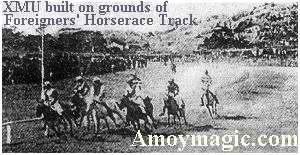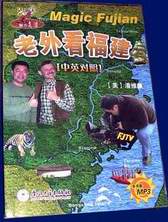![]() Click
to
Access
Click
to
Access
OUTSIDE China
![]() Click
to Access
Click
to Access
INSIDE
China ![]()
TRAVEL LINKS
![]() Xiamen
Xiamen
![]() Gulangyu
Gulangyu
![]() Jimei
Jimei
![]() Tong'an
Tong'an
![]() Jinmen
Jinmen
![]() Zhangzhou
Zhangzhou
![]() Quanzhou
Quanzhou
![]() Wuyi
Wuyi
![]() #1Fujian
Sites!
#1Fujian
Sites!
![]() Fujian
Foto Album
Fujian
Foto Album
![]() Books
on Fujian
Books
on Fujian
![]() Readers'Letters
Readers'Letters
![]() Ningde
Ningde
![]() Zhouning
Zhouning
![]() Longyan
Longyan
![]() Sanming
Sanming
![]() Putian
Putian
![]() Bridges
Bridges
![]() Travel
Info,
Travel
Info,
![]() Hakka
Roundhouses
Hakka
Roundhouses
![]() Travel
Agents
Travel
Agents
MISC. LINKS
![]() Amoy
People!
Amoy
People! ![]()
![]() Darwin
Driving
Darwin
Driving ![]()
![]() Amoy
Tigers
Amoy
Tigers
![]() Chinese
Inventions
Chinese
Inventions
![]() Tibet
in 80 Days!
Tibet
in 80 Days!![]()
![]() Dethroned!
Dethroned!
![]()
![]() Misc.Writings
Misc.Writings
![]() Latest
News
Latest
News
![]() Lord
of Opium
Lord
of Opium
![]() Back
to Main Page
Back
to Main Page

![]() Order
Books
Order
Books![]() Xiamenguide
Forum
Xiamenguide
Forum 

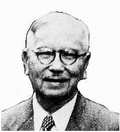 Tan
Kah Kee —"Henry Ford of Asia"
Tan
Kah Kee —"Henry Ford of Asia"
(not the
"Chicken guy" of Tan Kah Kee Fried Chicken, but the great "Rubber
Magnate!" & founder of Xiamen University)
From "
Xiamen
University--Strength of the Nation"
.by Dr.
Bill Brown & Robin Feifei-- almost 400 pages, bilingual
Chinese/English parallel, B&W and color photos, drawings, maps. 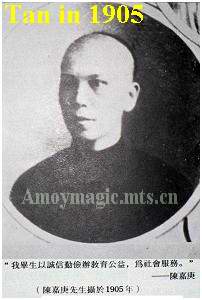
Click
Here for Chinese Version of This Page
Click Here The Rubber Magnate
Click Here The Frugal Philanthropist
Click Here Supporting Education Abroad
Click Here Xiamen University--Apple of Tan's
Eye
Click Here XMU Retreats to Changting
Click Here Tan's Final Years
Click Here Li Guangqian (Lee Kong
Chian)
Click Here Sa Ben Dong (XMU President
in Changting)
A Double
Portion of Tan’s Spirit
Innovative education is of course nothing new at XMU. Our university has
been pioneering all elements of modern education ever since it was founded
in 1921 by the “Henry Ford of Asia,” Mr. Tan Kah Kee. This
famous Overseas Chinese patriot gave an estimated USD 100 million to educa-tion,
thanks his business acumen and frugal lifestyle. But Mr. Tan left us much
more than mere money.
As I teach in Organizational Behavior, organizations’ personalities
often reflect those of their founders, and XMU is certainly no exception.
XMU’s 85 years of success show it has inherited a double portion
of Mr. Tan’s spirit and vision for a better China, a better Asia,
and a better humanity. 
Our university’s founder,
Mr. Tan Kah Kee (Chen Jiageng, 1874-1961), gave an estimated 100 million
USD to education over his lifetime but he was born into a humble family
of merchants in the village of Jimei, on the mainland across from Xiamen
Island. Tan worked the fields and the fishnets until he started school
at the age of nine, and in the fall of 1890 he moved to Singapore to help
in his father’s rice shop. His father’s business went under
in 1904, but the savvy son pulled together enough capital to buy 500 acres
of forested land in Singapore and started a pineapple plantation.
Back to top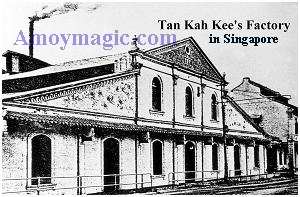
The Rubber Magnate
Tan rapidly expanded into rice milling, manu-facturing, sawmills, real
estate, and ocean transport, but it was rubber that really stretched his
fortune. He set aside a few acres of his pineapple planta-tion and eventually
had 10,000 acres of rubber trees. His expansion from rubber planting to
rubber manufacturing helped create the rubber industry and made him one
of the four great Rubber Barons.
By the mid 1920s, the Rubber Magnate’s Singapore-based empire em-ployed
over 30,000 people, had 150 offices on 5 continents, and did business
with 48 countries. But prices plummeted after 1926 and rubber never quite
bounced back. Even worse, after Mr. Tan protested Japan’s brutal
“Jinan Massacre” (May 3rd, 1928), his factory was burned to
the ground. Yet even as he struggled through the Great Depression he continued
to finance Jimei School, Xiamen University, and Chinese and English schools
in Singapore—a feat he managed in part because of his frugality.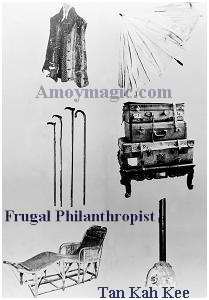
The
Frugal Philanthropist Rich philanthropists
generally give but a fraction of their wealth while alive, but leave behind
large foundations since the only thing they can take with them when they
die is their reputation. But Mr. Tan quite literally gave like a prince
while living like a pauper, subsisting on little more than rice porridge
and potatoes, and using the same umbrella and battered suitcases for decades.
Other rich Chinese of his day built luxurious villas on nearby Gulangyu
Islet, but Mr. Tan contented himself with a sim-pler home in his native
Jimei. As he wrote to a relative, his hometown still had great needs and
“I cannot put myself before the community.”
The Japanese destroyed Tan’s home in 1938, and when the Chinese
government offered to rebuilt it after Liberation, Tan insisted that war-damaged
school buildings be rebuilt first. His home was finally renovated in 1955
and he lived there from 1958 until 1960, when he moved to Beijing. Tan’s
house was restored to its original design in 1980 and is now a museum
and meeting place for the Jimei School Committee. I think the most moving
exhibits are the battered suitcases, umbrellas and worn-out shoes that
the “pauper millionaire” used for decades.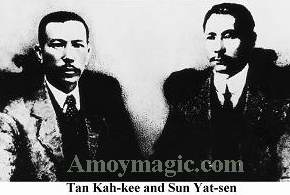
Mr. Tan’s Vision for China Mr. Tan was a social
and political reformer from youth. He supported Sun Yat-sen, and at one
point accounted for about 1/3 of the Kuomintang’s finances (a feat
he no doubt regretted when Chiang Kai Shek absconded to Taiwan with his
money and everyone else’s). But Tan’s greatest hope for China
was in modern education.
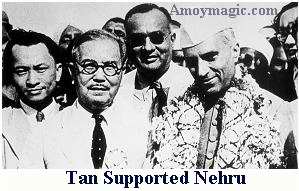 In 1894, at age 21, Tan began a family school in Jimei. In 1912, during
the first year of the new Republic of China, Tan returned to China and
on January 27, 1913 opened the Jimei Primary School. Between 1920 and
1926 he opened a school a year until Jimei School Village had 11 schools,
includ-ing a middle school and schools in agriculture, commerce, forestry,
navigation, etc. In addition, Jimei School Village’s education promotion
department donated to more than 70 middle schools and primary schools
throughout Fujian province.
In 1894, at age 21, Tan began a family school in Jimei. In 1912, during
the first year of the new Republic of China, Tan returned to China and
on January 27, 1913 opened the Jimei Primary School. Between 1920 and
1926 he opened a school a year until Jimei School Village had 11 schools,
includ-ing a middle school and schools in agriculture, commerce, forestry,
navigation, etc. In addition, Jimei School Village’s education promotion
department donated to more than 70 middle schools and primary schools
throughout Fujian province.
Back to top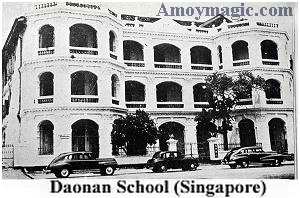
Supporting Education Abroad
Tan also began or funded at least seven schools in Singapore,
including Tao Nan (1907), Ai Tong (1912), Chung Fook Girls School (1915),
Chung Poon (1915), the Singapore Chi-nese High School (1918), Nanyang
Normal School (1941) and Nan Chaio Girls High School (1947). . His largesse
was not limited to Chinese schools. He gave $30,000 to the Anglo-Chinese
School in 1919 and in 1941 gave $10,000 to Raffles College, which later
merged with the Medical College and eventually became the University of
Singapore.
Xiamen University—Apple of Tan’s
Eye In early November, 1920, Mr. Tan offered  one
million Yuan to start Xiamen University, which began with the Normal and
Commerce Departments, and later expanded to five Colleges and 17 departments
in Literature, Science, Law, Commerce and Education. Xiamen University
captured the imagination of Chinese and foreigners alike. In the 1920s,
Paul Hutchinson wrote,
one
million Yuan to start Xiamen University, which began with the Normal and
Commerce Departments, and later expanded to five Colleges and 17 departments
in Literature, Science, Law, Commerce and Education. Xiamen University
captured the imagination of Chinese and foreigners alike. In the 1920s,
Paul Hutchinson wrote,
“This school [Xiamen University] is entirely a Chinese institution, with no foreign teachers and no foreign connections, and right out in a small Chinese village. The course of study is being made very practical… When we think of the future days, it is one of the most encouraging things to be seen in the whole of China.”
Mr. Tan emphasized quality education. He sent students
abroad, hired teachers from other areas, purchased the latest equipment,
and emphasized sports. By the spring of 1937, his financial fortunes had
so suffered that he allowed the government to take over Xiamen University,
but he continued to subsidize it. Tan wrote to the minister of education
that he had had “a fine start and a poor finish,” and would
“live in perpetual regret.” [If only he could see XMU today!]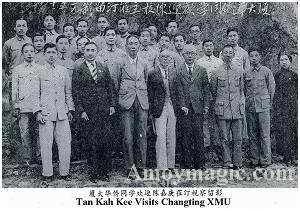
Back to top
XMU Retreats to Changting
That same year, Xiamen University relocated to Changting in West
Fujian to escape destruction by the Japanese, who had occupied Xiamen.
[Read more in the next chapter, “Sa Bendong”]. The Japanese
surrendered in August, 1945, and on October 21, 500 mass organizations
in Singapore welcomed Tan’s return from a decade of exile in Java.
A large meeting in Chongqing on November 18, 1945, celebrated Mr. Tan’s
safety, and Chairman Mao inscribed a scroll about Tan which read, “Banner
of Overseas Chinese, Glory of the Nation.” 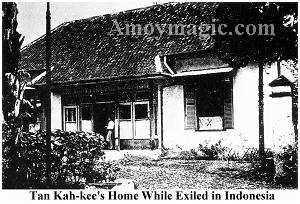
XMU returned to Xiamen after Japan’s defeat and
the new president and eminent biologist, Dr. Wang Deyao, immediately set
out rebuilding and ex-panding the campus. Tan’s vision and money
and Wang’s leadership paid off. XMU was designated a key national
university in 1962 and has been mushrooming ever since.
On October 1, 1949, Chairman Mao invited Mr. Tan to Tiananmen to participate
in the ceremony of the founding of the People’s Republic of China.
Tan settled down in his homeland in 1950 and devoted the rest of his life
and fortune to its reconstruction.
Back to top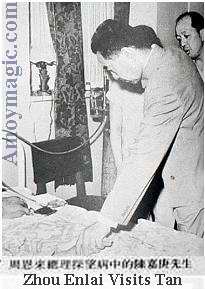
Tan’s Final Years
During his last years Mr. Tan served in many posts, including
Chairman of Returning Overseas Chinese League, Member of the Standing
Committee of the National People’s Congress, and Vice-Chairman of
the CPPCC. He was also responsible for innovations like China’s
first sea-spanning bridge (the award-winning Xiamen-Jimei bridge), the
Jimei Dragon Boat Pool, which has hosted numerous domestic and international
aquatic events, and Jimei’s 15 storey Nanyuan Building, which has
a navigational light on the roof to guide fishermen safely home.

Mr. Tan died of cancer in 1961, and after a State Funeral in Beijing,
a special train transported his body to his hometown of Jimei. Tan left
behind three million Yuan in banks, but the man who gave like a prince
and lived like a pauper evidently expected his descendants to do the same—or
make their own fortune. He left no money to his family, but gave half
a million to Jimei School Foundation, half a million to construct Beijing’s
Overseas Chinese Museum, and over two million Yuan for education.
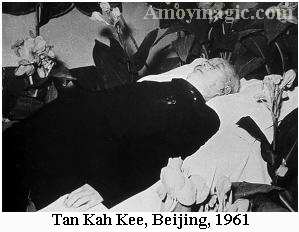
Tan’s International Legacy Altogether, Mr. Tan
gave an estimated 100 million USD towards education, both in China and
abroad, and the Tan Kah Kee Foundation has been awarding a Postgraduate
Scholarship since 1983. In 1986, Nobel Prize Laureate Prof. C.N. Yang
set up the Tan Kah Kee Inventors’ Award, and in 1992, Prof Yang
and two other Nobel Prize Laureates, Prof Samuel C.C. Ting and Prof Li
Yuan Tseh, together with Prof Changlin Tien, former Vice-chancellor of
the University of California at Berkeley, and Prof Wang Gungwu, former
President of Hong Kong University, set up the Tan Kah Kee International
Society Foundation to the advancement of education and culture in the
spirit of Tan Kah Kee.
 In
1991, Singapore’s president, Dr. Wee Kim Wee, launched the University
Endowment Fund in honor of Mr. Tan, and set a goal of raising 1$ billion
for education. On 11 March, 1990, the International Asteroid Center of
China named Asteroid 2963 “Tan Kah Kee Star.” The naming ceremony
was held at Xiamen University.
In
1991, Singapore’s president, Dr. Wee Kim Wee, launched the University
Endowment Fund in honor of Mr. Tan, and set a goal of raising 1$ billion
for education. On 11 March, 1990, the International Asteroid Center of
China named Asteroid 2963 “Tan Kah Kee Star.” The naming ceremony
was held at Xiamen University.
Lastly, the School of Chemistry in my home state’s University of
California, Berkeley, has a “Tan Kah Kee Hall.” I hope more
and more foreigners and Chinese alike will come to understand, and emulate,
Tan Kah Kee’s spirit of sacrificial giving.
“A good traveler is one who does not know where
he is going to, and a perfect traveler does not know where he came from.”
Lin Yutang
Back to top

TRAVEL
LINKS  Favorite
Fujian Sites
Favorite
Fujian Sites  Fujian
Foto Album
Fujian
Foto Album  Xiamen
Xiamen
 Gulangyu
Gulangyu
 Fujian
Guides
Fujian
Guides  Quanzhou
Quanzhou
 Zhangzhou
Zhangzhou
 Longyan
Longyan
 Wuyi
Mtn
Wuyi
Mtn  Ningde
Ningde
 Putian
Putian
 Sanming
Sanming
 Zhouning
Zhouning
 Taimu
Mtn.
Taimu
Mtn.  Roundhouses
Roundhouses
 Bridges
Bridges
 Jiangxi
Jiangxi
 Guilin
Guilin
 Order
Books
Order
Books
 Readers'
Letters
Readers'
Letters
Last Updated: May 2007
![]()
DAILY
LINKS
![]() FAQs
Questions?
FAQs
Questions?
![]() Real
Estate
Real
Estate
![]() Shopping
Shopping
![]() Maps
Maps
![]() Bookstores
Bookstores
![]() Trains
Trains
![]() Busses
Busses
![]() Car
Rental
Car
Rental
![]() Hotels
Hotels
![]() News
(CT)
News
(CT)
![]() Medical
& Dental
Medical
& Dental
![]() YMCA
Volunteer!
YMCA
Volunteer! ![]()
![]() XICF
Fellowship
XICF
Fellowship
![]() Churches
Churches
![]()
![]()
![]() Temples
Temples![]()
![]() Mosque
Mosque
![]() Expat
Groups
Expat
Groups
![]() Maids
Maids
![]() Phone
#s
Phone
#s
EDUCATION
![]() Xiamen
University
Xiamen
University
![]() XIS(Int'l
School)
XIS(Int'l
School)
![]() Study
Mandarin
Study
Mandarin
![]() CSP(China
Studies)
CSP(China
Studies)
![]() Library
Library
![]() Museums
Museums
![]() History
History
DINING ![]() Tea
Houses
Tea
Houses
![]() Restaurants
Restaurants
![]() Asian
Asian
![]() Veggie
Veggie
![]() Junk
Food
Junk
Food
![]() Chinese
Chinese
![]() Italian
Italian
![]() International
International![]()
![]() Visas
4 aliens
Visas
4 aliens
RECREATION
![]() Massage!
Massage!
![]() Beaches
Beaches
![]() Fly
Kites
Fly
Kites
![]() Sports
Sports
![]() Boardwalk
Boardwalk
![]() Parks
Parks
![]() Pets
Pets
![]() Birdwatching
Birdwatching
![]() Kung
Fu
Kung
Fu ![]() Hiking
Hiking
![]() Music
Events
Music
Events
![]() Cinema
Cinema
![]() Festival&Culture
Festival&Culture
![]() Humor&
Humor&![]() Fun
Fotos
Fun
Fotos![]()
BUSINESS
![]() Doing
Business
Doing
Business
![]() Jobs!(teach/work)
Jobs!(teach/work)
![]() Hire
Workers
Hire
Workers
![]() Foreign
Companies
Foreign
Companies
![]() CIFIT
(Trade Fair)
CIFIT
(Trade Fair)
![]() MTS(Translation)
MTS(Translation)
![]()
Back to Top
